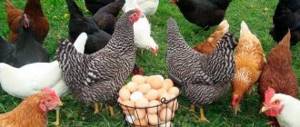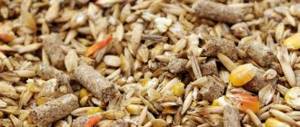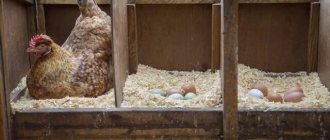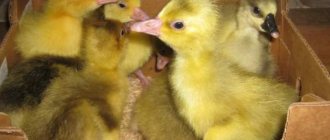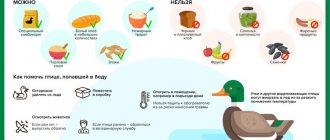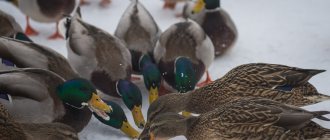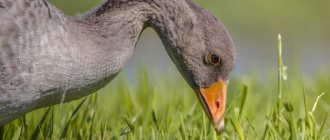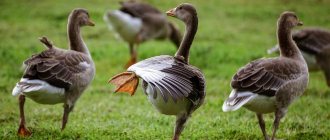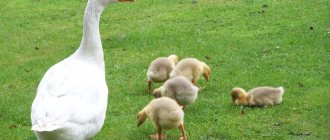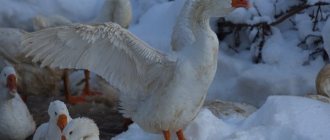Despite its behavior, the chicken goose belongs to the order Anseriformes, the duck family. In appearance the bird resembles a goose. But her habits indicate a chicken nature. What does it cost to just dig up roots from the ground? It’s interesting that you won’t hear the usual goose cackle from these birds. Their voice is more like the muffled grunt of a pig. From our article you will learn all the features of this unique bird.
Characteristics of appearance
Chicken geese are endemic - birds that live in a limited area with a small geographic area. Indeed, the habitat of these birds is small: the island of Tasmania and the southern coast of Australia.
The chicken goose cannot be confused with other representatives of the Australian and Tasmanian fauna. The powerful bird reaches a meter in height. Weight can vary from 3 to almost 7 kilograms. There are other distinctive appearance features:
- the base color of the plumage is light gray;
- the tips of the tail and wings are emphasized by black feathers;
- black and white streaks are scattered on the wings;
- on a small head there is a white cap;
- short beak, black below, curved tip, reminiscent of a chicken (another detail for which the species received its name);
- short neck;
- wide chest;
- bright red strong legs, the color of which from the tarsus and below turns black;
- small membranes between the fingers.
Features of the behavior of the chicken goose
Galling geese are sociable birds, but they tend to live in small flocks of rarely up to 300 birds. They are found closer to the shore, but they rarely swim and do not always go into the water, even if they are in danger. Like most other anatidae, chicken geese lose their ability to fly during the moult, when their wing and tail feathers are shed. This type of geese, if life is threatened, makes a loud noise that scares away predators. The flight of chicken geese is powerful, consisting of rapid wing beats, but a little heavy. They often fly in flocks.
Chicken geese are sociable birds
Nutrition and behavior in nature
Chicken geese are flocking birds, breaking up into paired groups only during nesting.
The powerful legs of chicken geese are adapted for fast running. They swim in water only during the mating season and do not like to fly. And if they take off, it’s hard, often flapping their wings.
During the molting period, birds are most vulnerable - they do not fly at all, avoid water and make loud noise to scare away predators. The birds' main enemies are the Tasmanian devil and the wild dog dingo.
Birds feed on plant foods that grow near water bodies and in pasture meadows. With the help of strong legs and a strong beak, they dig up the ground and eat the roots of plants.
By destroying meadow grass, birds cause damage to agrocenosis - an artificial ecosystem created by man. They do not leave food for the sheep grazing in their habitat.
The specifics of Australia, as the driest continent on the planet, also makes adjustments to the life of the chicken goose. In the summer, when the forage grasses dry out in the area where they live, the birds gather in flocks and fly to areas rich in food. With the onset of the autumn rainy season, geese return to their usual habitats.
Features of joint feeding
To avoid conflicts during feeding, each species of bird is fed in a separate enclosure.
The birds are fed separately, each species in its own compartment. However, when walking in a common yard, feeders and drinking bowls are installed. To avoid water splashing, nipple drinkers are installed.
A mesh partition is installed over the feeders to prevent birds from scattering food. Geese feed first. Once satiated, they do not mind approaching duck feeders. The chickens eat last.
Be sure to read:
Common diseases of ducks: why do ducklings roll over on their backs and twitch their paws?
The disadvantage of this approach is that the diet is unbalanced: the nutritional needs of birds of the same species are not the same.
Dignity is the pleasure gained from watching waterfowl and chickens pecking from the same feeder.
Nesting period
The breeding season of chicken geese lasts from April to September. Birds are monogamous and form pairs for life. But if a partner dies, they look for a new one.
Before mating, the goose watches the ritual dance of the future partner. The chicken goose runs and flaps its wings, showing off its physique. If his efforts are crowned with success, a pair is formed and nesting begins.
Geese settlements are formed in the form of colonies, where the construction of nests for each pair is carried out at a respectful distance from each other.
The goose and gander jointly choose a hole among stones, grass or bushes. And they cover it with feathers, down plucked from themselves, and dry grass. The result is a cozy nest, made much more skillfully than that of other types of geese.
Habitats of the chicken goose
During the breeding season, chicken geese choose places on the banks of the river, stay in the meadows of small islands and feed along the shore. After nesting, they occupy coastal meadows and lakes with fresh or brackish water in open areas. Most often, chicken geese live mainly on small, windswept and uninhabited offshore islands, but venture into adjacent agricultural areas of the mainland in search of food in the summer. Their ability to drink salt or brackish water allows large numbers of geese to remain on the outlying islands year-round.
During the breeding season, chicken geese choose places on the banks of the river
Breeding offspring
The female lays up to 6 yellowish eggs in the nest. It takes 35 days before the offspring are born. All this time, the male zealously protects his chosen one and future children from any danger. In emergency situations, he shows aggression and is capable of attacking the enemy.
Chicks of the brood type behave independently from the first days of life. Parents work together to protect them and prepare them for adulthood. The gander puts on airs, walking ahead of the family with a proud look.
The chicks are fed by their parents for 2-3 months, during which the young ones learn to fly. The young settle together with other members of the flock who do not yet have their own nesting place.
Chicken breeding
In order to start breeding chickens, day-old chicks or eggs are purchased from the manufacturer, which are then incubated. Incubation lasts 26 days. After this, the young animals are placed in a brooder, where an infrared lamp is installed. The chicks stay in the brooder until they are one month old. Next, poultry farmers choose one of the maintenance methods: on litter or in cages. Young broiler breeds are most often kept in cages. Individuals are fattened for up to 60 days. Choose crosses:
- "Gibro-6";
- "Broiler-61";
- "COBB-50";
- "Change".
READ ALSO: White currants: benefits and harms
Broilers grow faster if you use combined feed, but if this is not possible, then a certain diet is prepared for them:
The feed table consists of a grain mixture, which includes barley and wheat:
- be sure to add protein fillers, sunflower cake or soybean pulp;
- for better development of the skeletal system, young animals are given bran, chalk, salt, bone meal, and fish oil;
- succulent food will replenish the body with vitamins and mineral salts: alfalfa, nettle, vegetables;
- It is recommended to give boiled potatoes.
A similar diet is also used for meat breed chickens. Not only meat, but also eggs are obtained from them. On average, one laying hen can produce 100 eggs per year, weighing 65 g. Most meat breed chickens have decorative plumage. They are used to decorate the courtyard. The following breeds are distinguished among meat animals:
| № | Helpful information |
| 1 | cochin |
| 2 | gate |
| 3 | Cornish |
| 4 | Malin |
| 5 | Plymouth Rocks |
At 2 months, birds gain 2.5 kg. Subsequently, broilers begin to grow more slowly, so they are sold at an early stage of fattening. Individuals of meat breeds, unlike crosses, continue to grow and develop. An adult rooster can gain body weight up to 6 kg.
Chicken breeding
Laying hens are bred to produce eggs. They are distinguished by early maturation. A chicken can lay its first clutch as early as 5-6 months. Leghorns are the egg-laying champions. A laying hen can lay up to 350 eggs per year. Chickens of the egg breed are given not only grain mixtures rich in protein, but also many additives, which include minerals.
They are necessary not only for the normal development of the bird, but also for the formation of the egg shell. For laying hens it is recommended to feed mash. Wet food stimulates laying. The chicken receives up to 200 g of feed per day. Individuals of the meat breed eat 200-230 g.
Conservation status
The number of chicken geese is small - about 8 thousand heads. However, there is no threat of extinction.
There were stages in the history of the species when it could have disappeared from our planet, but timely measures taken made it possible to stabilize the situation and preserve the population.
People killed chicken geese for meat and fun. But in the 20th century, Australian authorities passed a law prohibiting the destruction of these birds.
The chicken goose came to Eurasia at the end of the 20th century. It was from those times that the species became a permanent resident and decoration of zoos in Europe.
If treated well, birds can breed in captivity. Conservationists are taking care of their pets, trying to increase their numbers.
Main difficulties
The main problem with cohabitation is that ducks and geese are waterfowl. They love to swim and drink copiously of their food, splashing everything around them. Chickens, on the other hand, need dry bedding and tend to scatter their food.
As a result, when these birds live together, dampness and dirt are formed, which is a breeding ground for infections and parasites such as:
Chicken mite: diseases caused by the parasite
Further
Chicken lice: description of parasites and diseases they cause
More details
Chicken bugs are parasites that are carriers of dangerous diseases.
Look
Beetles, lice eaters and fleas in the poultry house: how to deal with them using traditional methods?
Read
In addition, geese, due to their unfriendly disposition, will constantly strive to show their superiority, provoking conflicts and trying to harm the weaker ones, which in this case will be chickens, which, in turn, will lead to a drop in egg production and a deterioration in the health of the latter.
The situation can be corrected by correct division of the territory.
Captivity
Recently, the chicken goose has begun to appear in private yards as a pet. But attempts at domestication rarely end in success - the bird often conflicts with other birds, attacks its owner, and flies over fences.
In order for geese to like captivity, they need:
- a fenced paddock of more than 200 m2 with lush vegetation;
- a house with a roof where the geese can hide in bad weather;
- heated poultry house in winter (per bird - 1 m2);
- a body of water that stimulates reproduction;
- a thick layer of hay as bedding and feed (it must be periodically added and renewed as it gets dirty);
- additional complementary foods: fresh vegetables and fruits, animal feed, wheat, worms, insects, shellfish.
We hope you found the article interesting. In the comments you can share your impressions of what you read. We will be grateful for your like and repost.
What breed of geese should I choose for breeding?
There are many breeds of geese, like other poultry. They are divided according to climatic zones (in which they are most comfortable), purpose and conditions of detention. It is not profitable for the farmer to constantly purchase new young stock. You need to master raising geese from eggs yourself. You shouldn't rely too much on mother geese. They don't really care about their offspring. Incubators for goose eggs will come to the aid of the farmer. They are imported and domestic. The first models are designed, as a rule, for a small number of eggs. Our devices can accommodate more than a hundred eggs.
Here is a comparative table in which you can see the advantages and characteristics of some breeds:
| Breed | Signs and characteristics |
| Khokhloma | These are one of the largest birds. They have a growth on the forehead and a fold under the lower jaw. This is how they are recognized externally. An adult can weigh about 10 kg. The female produces about 40 eggs per year. These are unpretentious birds, resistant to disease. They can be bred in different climatic zones. |
| Large gray | Heavy large specimens. Adult males weigh 8 kg, and females 6 kg. The latter can lay 40 eggs in a year, but are not inclined to hatch. The breed acclimatizes well and quickly adapts to living conditions. |
| Toulouse | Bred in the warm climate of France. They gain weight well, move little and practically do not graze. Ganders weigh about 12 kg. This breed is used if you need to master breeding geese for liver. It can weigh about 1 kg per individual. |
| Landshskaya | This breed was imported from Hungary, where it was also bred to produce liver. An adult weighs about 8 kg. |
| Italian whites | Another breed for breeding for liver. At the same time, the birds provide good weight gain and a large yield of meat. The gander weighs about 9 kg. |
| Chinese | This breed has a high egg production. You can expect up to 100 eggs per year from a female. These birds are actively used in breeding work to increase this indicator in representatives of other breeds. |
Is it possible to keep ducks, chickens and geese together?
Of course you can, they don’t interfere with each other at all!
My parents always do this, only if the ducklings are very small, then they need to grow up a little to move in with the chickens. This year the chickens bought were a little wild, so the mother is raising the ducklings at home and then relocating them. We don't keep ducks or chickens, but our neighbors keep both. They live together in the same barn and walk together in the yard. Not that they are together in pairs, of course, but, as you can see, they do not interfere with each other at all, even when they have chicks. So you can safely create a “dorm” for them.
My grandmother’s chickens and ducks always lived together, in the same coop, and they also “walked” in the same flock. I didn’t even think about whether this was right or wrong. They lived amicably, did not interfere with each other, the chickens spent the night on the roost, the ducks under the wall on straw or something similar.
I don’t know whether it’s right or wrong, but we held on. Nothing terrible seemed to happen. True, they were not kept in a stable, but right in the house. We have two houses, so we decided to give one to animals for the winter, because it’s warmer there and there’s more space.
It is possible to keep chickens and ducks together. They themselves did this on the farm more than once.
The main thing is that the chickens have poles attached to them at a height of half a meter or higher, so that they sit on them and spend the night. The ducks are located below and will not interfere with the chickens. There is nothing wrong with keeping this bird together. They even feed on almost the same food.
